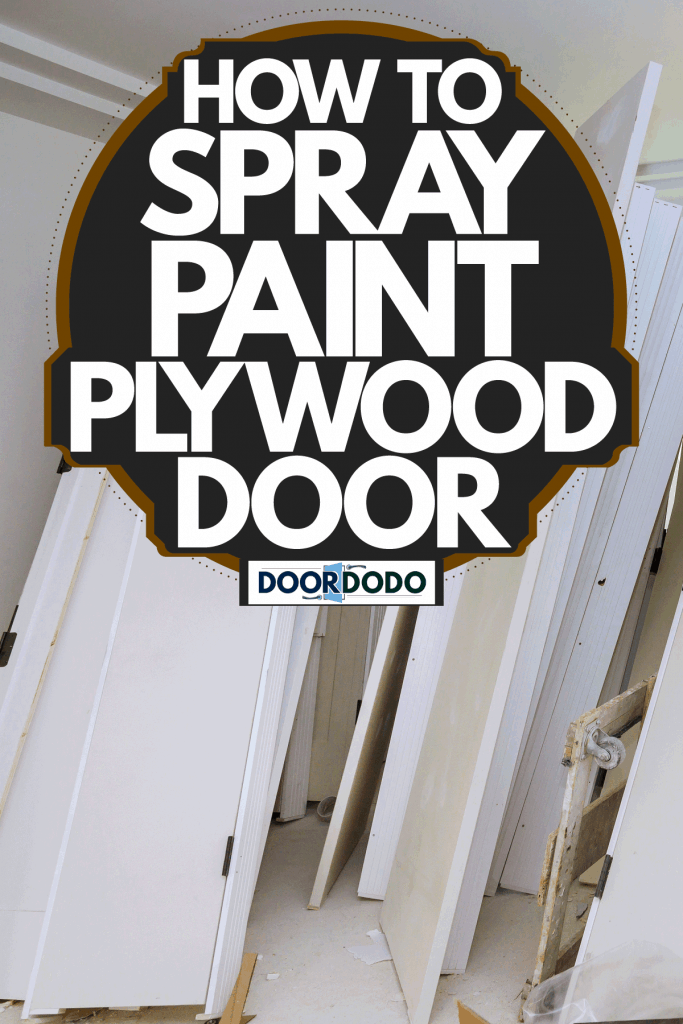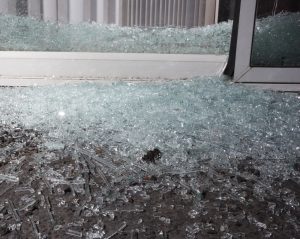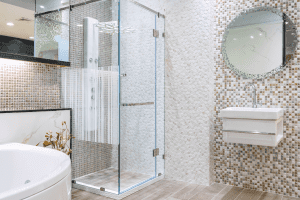Plywood is a popular choice among homeowners as a cheaper alternative to hardwood without losing the sturdiness and durability the latter offers. When using it for doors, it's vital to know the proper preparation and maintenance to reduce wear. But with what other methods can you paint a plywood door, and how should you do it? We've looked into these questions and discussed the answers in this post.
An easy painting method is to spray paint a plywood door. You can do this by following these basic steps:
- Prep the door, tools, and work area.
- Apply primer on both sides of the door.
- Use the sprayer to paint over the plywood door.
In spray painting a door, you might be wondering whether it works better than the typical paint rolling. Keep reading as we delve into the differences between traditional and spray painting, how to spray paint interior doors and their door jambs, and suggestions on recommended plywood paint and spray guns.

How Do You Spray Paint An Interior Door?
Painting an interior door such as a plywood door with a traditional paintbrush can take a while to complete, especially when you have to apply multiple coats. Spray painting shortens the time it takes to coat an interior door.
The process it follows is similar to rolling but uses different techniques because of the medium. The video below demonstrates how to spray paint a door:
To start, prepare the following materials and tools:
- Goggles, a mask, and gloves
- Wood paint
- Wood primer
- Paint sprayer or spray gun
- Newspapers and paper tapes
- Sandpaper
- Clean cloth
Continue reading for a summary on each step to take in spray painting interior doors that also includes plywood doors:
1. Prep The Door, Tools, And Work Area
Get your tools and materials ready before you start painting. Wear the required protective gear to prevent any harm.
If you are painting the door unhung, set them on two boxes, sawhorses, or stools throughout the process. If the door will remain installed, cover up the surroundings with newspapers or cloth to keep paint from spreading.
Use paper tapes to cover the hardware on the door that you won't be painting. If the door has any holes, fill them up with vinyl or epoxy. To finish the door preparation, carefully sand down both sides and the edges of the door enough to smoothen it, then wipe it down with a clean cloth.
If the door needs cleaning, get some tips by reading our post on How To Get Oil And Grease Marks Off Oak Doors.
2. Apply Primer On Both Sides Of The Door
Priming a plywood door before painting is optional, depending on the door's condition. The wood primer keeps the paint from being absorbed by the wood, helping it maintain its pigment and tone. It limits the number of coats you have to apply and prevents colors from dulling.
Apply about two coats of wood primer to the door using the paint sprayer. Sand it once dry, then wipe off the dust with a clean cloth. Repeat this on the other side.
Get the KILZ Premium high-hide stain-blocking primer on Amazon.
Some doors are already pre-primed by manufacturers, meaning you can go straight into painting them. The same applies to plywood doors that have already been primed and painted in the past.
3. Use The Sprayer To Paint Over The Plywood Doors
Adjust the paint sprayer to allow it to spray just enough paint onto the door. Too much paint output may cause it to leak and cause color and texture imbalance.
Once you're ready, start painting the edges of the door. When spraying over the body, maintain a consistent speed and direction. Let the paint overlap about half of each spray to ensure it gets fully coated. Apply as many coats as necessary.
If you are painting for a front door, get further insight from our post: Should A Front Door Be Painted On Both Sides?
Tip: Do not stop or let go of the trigger in between the strokes unless you reach the top or bottom of the door. It would be harder to fix the unevenness at the center areas of the door.
How To Spray Paint Interior Door Jambs
When painting interior doors a new color, it would be best to give the door jambs a fresh coat too. Spray painting them follows a process similar to painting the door itself. These steps explain how to do it:
- Cover up the surrounding area of the door jambs that you will not paint. These include the walls, floor, and other nearby items.
- Once everything is covered, prime the door jambs by applying a coat of wood primer. Lightly smoothen them with sandpaper and wipe them down after coating. Do this about two times.
- When the paint sprayer is ready, coat each side with paint in a consistent direction. Avoid stopping in between the strokes until you reach an end.
- Go over each side about 2 to 3 times or as many times as necessary. Door jambs tend to have hard-to-reach corners, so make sure the paint covers those parts. Let it dry when done.
Is It Better To Spray Or Roll Interior Doors?
For time efficiency and consistency, spraying is the ideal method to paint interior doors. The process takes only a few minutes, excluding preparation and drying time. A coat completes in about 3 to 5 minutes.
The main benefit of using a spray is the time it saves. Along with this, coats are likely going to be smooth even with less effort.
With rolling, it requires more work and time to finish. However, it's a convenient option for those who have smaller work areas or do not have access to purchase a paint sprayer or gun. The rolling method also allows you to fill in hard-to-reach spots.
What Kind Of Paint Do You Use On Plywood?
Plywood is the type of material that requires the appropriate paint to improve in appearance. You can use several kinds of paint on plywood, but there are a few that work exceptionally well with them. These are as follows:
Acrylic Latex Paint
The best paint to use on plywood is acrylic latex paint. These are water-based paints that are popular for being easy to use and clean. As opposed to oil-based paints, they dry quicker, spread evenly, and have less odor.
This paint is thin, so it tends to leave brush strokes or minor inconsistencies. But these can easily be covered up with additional coats. Even so, they are less prone to chipping, unlike other paint types.
Get the Rust-Oleum Painter's Touch latex paint on Amazon.
Acrylic Enamel Paint
Acrylic enamel paints produce a semi-gloss finish, while their oil-based options offer high-gloss finishes.
Enamel paints are best on plywood doors that will get frequent use because it hardens into a glass-like shell when dry. They also provide more resistance against dirt and harm, but they are harder to clean.
Get the Majic Pants Diamond Hard Acrylic Enamel paint on Amazon.
Epoxy Paint
An option for durability is epoxy paint. Other than providing an extra shine to a door, it also gives a protective coating that can withstand stains, spillage, and scratches. The properties of epoxy paint also create a moisture-resistant coat, reducing the risk of rapid wear.
Check out this Epoxy Paint and primer mix for coating MDF, plywood on Amazon.
What Is The Best Spray Gun For Painting Doors?
Next to choosing the best paint, it's also crucial to pick the best paint sprayer for doors.
Graco Magnum X5 Airless Paint Sprayer
This is the best spray gun to use on doors is because it allows easy control of paint flow and pressure.
Check out this Graco Magnum painter plus paint sprayer on Amazon.
Wagner Spraytech Control Spray Max HVLP
This sprayer also has received praise for providing versatility at a great price. It is recommended to use when doors come with fine details and require high precision.
See this Wagner Spraytech stain sprayer on Amazon.
In Closing
Spray painting plywood doors save you time during painting, especially when you have to apply multiple coats. The process involves the basic preparations followed by adjusting the sprayer until it is ready to use. Compared to rolling, a paint sprayer creates smoother, neater painting strokes.
The tools and materials you use during the painting process can affect the final result. Take your time in choosing which kind of paint and spray gun to achieve the best outcome. Good luck!









